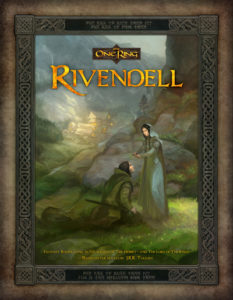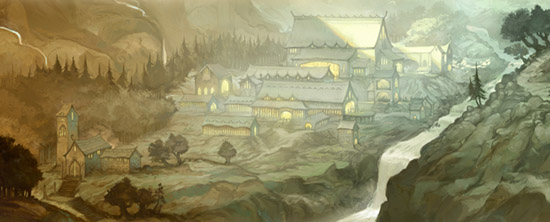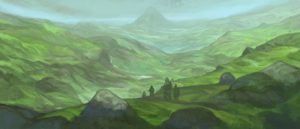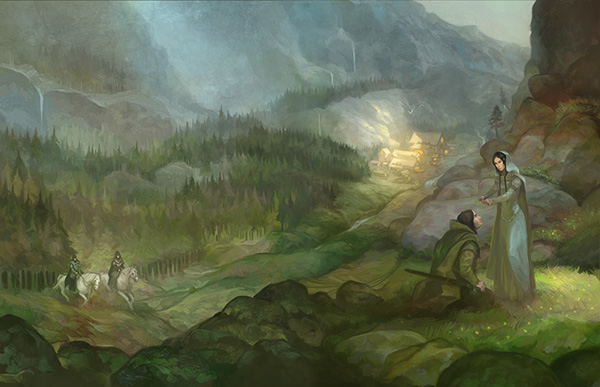RPG Review: The One Ring: Rivendell
“In all the days of the Third Age, after the fall of Gil-galad, Master Elrond abode in Imladris, and he gathered there many Elves, and other folk of wisdom and power from among all the kindreds of Middle-earth, and he preserved through many lives of Men the memory of all that had been fair; and the house of Elrond was a refuge for the weary and the oppressed, and a treasury of good counsel and wise lore. In that house were harboured the Heirs of Isildur, in childhood and old age, because of the kinship of their blood with Elrond himself, and because he knew in his wisdom that one should come of their line to whom a great part was appointed in the last deeds of that Age. And until that time came the shards of Elendil’s sword were given into the keeping of Elrond, when the days of the Dúnedain darkened and they became a wandering people.”

As I’m here in Busan, I’m working on prepping for a few campaigns when I head back to Spokane. One I’m preparing for is a campaign for The One Ring. I’m still not sure where I’ll have it set, or who will be playing, but I’m getting things ready anyway.
As I was going through my books, I began leafing through the Rivendell supplement, and knew I needed to tell you all about it. (If you need a catch-up to the system, you can read my previous review of the core rulebook here.)
Rivendell covers not only the Last Homely House, but the region of Eriador around it, stretching to Breeland in the west, the Misty Mountains to the east, up north to the broken ruins of Angmar, and far south to Dunland. The book begins with Imladris (as the Elves call it), detailing the manor and its outlying buildings. The book provides an extensive map, with a lot of detail about the house and its contents. You could spend hours here, exploring the halls.
The book then features the main inhabitants of Rivendell, with stats, including Elrond, his twin sons, Arwen (who has a great mechanic that the first time someone sees her, they increase their Hope), Erestor and Lindir, and a few others. It also features how to use the White Council as a patron for the party. The party also has quite a few things they can do there, which are detailed, such as researching lore, write a song, or reduce the effects of the Shadow. The book actually has rules for composing music, along with the difficulty based on what style of song it is.
The book then covers the history of Eriador, from the establishment of the realm of Arnor forward through the rise and fall of Angmar, the Orc Wars, the Long Winter, and then the recent years. As a history major, I greatly enjoyed this, and they provided enough detail that I could easily manage a whole campaign set during the kingdom of Arnor, supplemented by some online reading to flesh it all out.

The following section then makes up a majority of the book, covering all of Eriador. You’ll find important characters and locations here, each one detailed enough to provide some great story hooks. There’s a lot of information on the Trollshaws and the Ettinmoors, and the trolls which inhabit those regions. The details on the Barrow Downs is also very interesting, because it fleshes out the history of the area in a lot more detail than the novel did.
The Monster chapter details lots of interesting creatures, but of particular note is the new rules for the undead, and features not only the barrow wights and bog soldiers of the Ettinmoors, but a few pages about the Lord of the Ringwraiths in all his forms, including as the Witch King of Angmar. He gains different abilities based on how he appears in the world. As the Witch King, he has a Commanding Voice, and Great Might, emboldened by the strength of Mordor. His morgul blade is seen as well, needing the healing power of a healer on par with Elrond. If he isn’t healed by a master of the healing arts, after 10 days plus his Heart rating, he dies, rising again as a Fell Wraith. Even if he does heal, any time he traverses through a blighted area causes the wound to flare up again and becomes weary.

The Magical Treasure index featured in the book allows game masters to prepare treasure beforehand, specially tailored to the PCs. Stumbling upon an ancient elven blade, or a magical ring isn’t a matter of random chance, but fate. Magical items recieve a lot more time here than in the core rulebook, explaining how they can grant blessings to important skills. There follows rules for the GM to craft famous weapons and armor, deciding where they come from, their banes, and weapon qualities. Naming them is essential as well. When a character aquires a famous item, they unlock only the first special quality of the item; gaining Valor or making the magical item a cultural treasure can unlock further hidden qualities. Not only does the book help you make these powerful and ancient items, it also walks through how to create a cursed item as well.
The next major section has optional rules for the Eye of Sauron turning to gaze upon the party. Each race will have a starting Eye Awareness. Rolling Eyes on the Fate die will increase your score. Once the group’s total Eye Awareness reaches a certain threshhold, the party is no longer hidden from the awareness of the Shadow, and they become revealed. That threshhold is based on the region the party is traversing. This doesn’t only represent the Enemy seeing you, but also the balefulness of the land itself turning against the party. Perhaps when they arrive in town, they recieve a colder welcome. Any ally may become a foe through lies or sorcery. One enemy they face may gain the quality No Quarter. The Eye Awareness only resets when one of these Awareness Encounters takes place.
The final section details two new cultures: The High Elves of Imaldris and the Dunedain Rangers of the North. Neither of these count as “starting characters,” though they may be created at the beginning of a campaign; It isn’t recommended, but it is an option. They are a little more powerful than the other party members, if no one else plays one of these. As a result, there are some rules to help balance them out. Rangers contribute to the Fellowship pool, but do not spend Fellowship points to recover lost Hope. High Elves have a harder time losing the taint of the Shadow on their spirits. They aren’t able to choose the Heal Corruption action during the Fellowship phase. Instead, they can roll using one of their skills to reduce it, but then can never again use that skill to reduce the corruption. Whenever they use that skill, they have a chance of being overwhelmed by hopelessness. This means that your character actually has a shelf life, and will eventually need to abandon the party and diminish, going into The West. I absolutely love this rule, as it feels so very, very Tolkien.
The art throughout the book is just as good as it’s always been, very evocative, flavorful, and leaning more toward the traditional art of the novels than that of the films.
Rivendell is a book you must get if you are running The One Ring. Even if your characters remain East of the Misty Mountains, the rules for High Elves, Magical Items, and Eye Awareness alone are worth it.
You can pick up Rivendell at DriveThruRPG (affiliate link).

